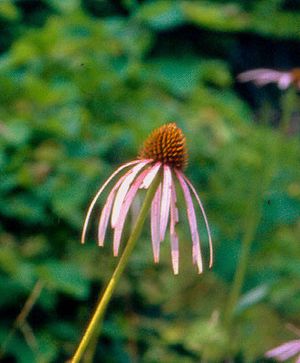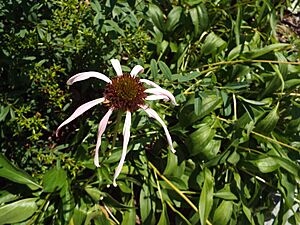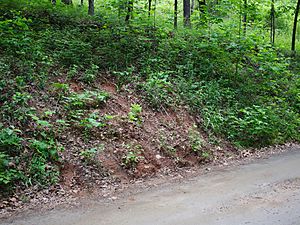Smooth purple coneflower facts for kids
Quick facts for kids Smooth purple coneflower |
|
|---|---|
 |
|
| Conservation status | |
| Scientific classification | |
| Genus: |
Echinacea
|
| Species: |
laevigata
|
| Synonyms | |
|
|
The smooth purple coneflower (Echinacea laevigata) is a special plant found in the eastern United States. It is listed as an endangered species. This means it is in danger of disappearing forever. Most of these plants grow in sunny, open areas like roadsides. They often prefer soils rich in calcium and magnesium.
Contents
What is the Smooth Purple Coneflower?
The smooth purple coneflower is a plant that grows back every year. It has underground stems called rhizomes. This plant looks a lot like its cousin, the common echinacea (Echinacea purpurea). You can tell them apart by their leaves. The common echinacea has heart-shaped leaves.
E. laevigata can grow up to about 1.5 meters (5 feet) tall. Its stem is mostly smooth and has few leaves. Any leaves it does have are shaped like a spear. At the top of the stem is a flower head. This head has narrow pink or purplish petals, called ray florets. These petals can be up to 8 centimeters (3.2 inches) long. They droop away from the center of the flower. The small, tube-shaped flowers in the center are dark purple.
Life Cycle and Reproduction
This plant blooms from May through July. Its fruit is a small seed, about half a centimeter long. Birds and small mammals likely spread these seeds. They collect the seeds for food. Sometimes, new plants grow from the shared underground stem (rhizome). This is a type of vegetative reproduction.
Where Does it Live? (Habitat)
The smooth purple coneflower naturally grows in sunny spots within forests. These open areas were often created by wildfires. They were also made by fires set by Native Americans. Another way these areas stayed open was through animals grazing on plants.
The plant likes soils rich in calcium and magnesium. These soils include limestone, marble, gabbro, and diabase. Other plants that grow with it include eastern red cedar and rattlesnake master. There are also several types of oak trees. These oaks are usually small, letting sunlight reach the plants below.
As humans changed the forest habitat, the plant found new places to live. It now grows in other sunny spots. These include cedar barrens, clearcuts, roadsides, and areas around utility equipment. It also grows on limestone cliffs. Sadly, two-thirds of the known populations have disappeared.
Pollination
Many insects help pollinate the smooth purple coneflower. These include honeybees (Apis mellifera) and bumblebees (Bombus spp.). Other bees like Psithyrus citrinus and Xylocopa virginica also help. Different types of butterflies and a bug called Lygaeus kalmii also visit the flowers.
Where is it Found? (Distribution)
Today, the smooth purple coneflower is found in Virginia, North Carolina, South Carolina, and Georgia. In the past, it was also found in Pennsylvania and Maryland. This plant has always been rare. However, human activities have made its range even smaller.
There are about 100 groups of these plants left today. Many of these groups are not doing well. The amount of good habitat for this plant has shrunk a lot. It continues to get smaller.
Protecting the Smooth Purple Coneflower (Conservation)
The smooth purple coneflower faces many threats. These include more destruction of its land. People sometimes collect the plant, which harms its populations. Vandalism, herbicides, and new plant species that are not native also cause problems.
When the plant became an endangered species in 1992, most groups were small. Many had fewer than 100 plants each. Half of them were on roadsides. This makes them easy to destroy. Some people worry that this plant might be collected for herbal medicine. However, there is not much proof of this threat so far.
Smooth purple coneflower groups were lost when their homes were destroyed. This also happened when natural events like fires were stopped. The plant needs open areas to get sunlight. When fire suppression happens, the habitat becomes overgrown. This causes the open areas to close up. This has led to the plant disappearing from several places. Its habitat has also been destroyed by new buildings and farm work. Road building and installing things like gas lines also cause habitat loss.
Conservation Efforts
People are working to protect Echinacea laevigata. They are researching the best ways to bring back the natural cycle of disturbance to the land. For example, they are using controlled burns. This helps keep the areas open and sunny for the plant.




